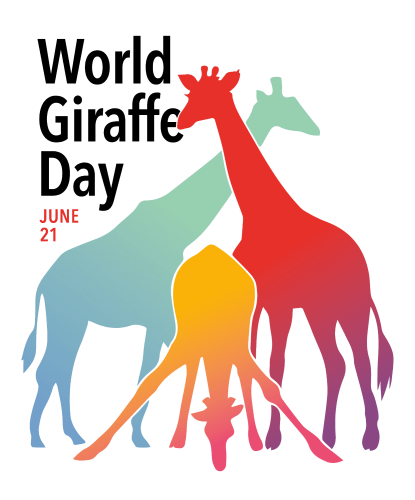World Giraffe Day 2025
Posted on
It’s not long now before we hit the 21st June – and of course what’s special about that is that it’s the longest day of the year – which means it’s World Giraffe Day, too!
World Giraffe Day gives us all an important chance to raise awareness of the challenges giraffes face in the wild.
Giraffe face a Silent Extinction if we don’t act
Over the past 35 years, giraffe numbers have decreased by nearly 30% and there are only about 117,000 giraffe left in the wild now. The Giraffe Conservation Foundation needs all our help in saving them. It initiated World Giraffe Day both to celebrate The Giraffe and to give us all the opportunity to help raise awareness of what giraffes face in the wild.
The giraffe's decline has been referred to as the Silent Extinction, by Sir David Attenborough in the BBC documentary, “Giraffes: Africa’s Gentle Giants”.
A video on You Tube from the Giraffe Conservation Foundation made in 2020 tells us that:
- Giraffe have gone extinct in at least 7 African countries
- In the last 300 years, we’ve lost 90% of all giraffe habitat
- Human population growth across Africa is having a huge impact on giraffe and other wildlife
The Foundation updates State of Giraffe every year, and this highlights the conservation efforts that are being made and also the status of wild giraffe in Africa.
Action is essential.
The Giraffe Conservation Foundation is the only organisation in the world which concentrates solely on the conservation and management of giraffe in the wild throughout Africa. Giraffe are still vulnerable to extinction, according to the IUCN Red List of Threatened Species.
It works in 15 African countries across 45 million acres of giraffe habitat. And it is making a difference to giraffe and I quote:
- Over 300 giraffe returned to their historical habitat
- 18 new giraffe populations established
- Over 100 giraffe born in original giraffe habitats
- Over 12 million acres of giraffe habitat reclaimed
- Over 5 million data points recorded
- Impact on over 100 million acres of giraffe habitat
Enter World Giraffe Day!
.
Zoos, schools, governments, companies and NGOs are hosting events to help raise awareness, and you can get involved and do your bit. Stick your neck out and raise awareness of giraffes and remind people of their beauty on social media!
Giraffe Translocation
The charity has a translocation programme, moving giraffe. Giraffe are moving to areas where there are very few or no giraffe. They are also caught, and then given satellite tracking units so that they can be tracked which enables conservationists to find out more about their movements. Catching and tracking giraffe provides an excellent opportunity to find out as much as possible about these beautiful animals. You can look at these two videos to get an idea of what's involved...
Returning Angolan Giraffe to their Natural Homeland
The Longest Wild Giraffe Translocation Ever undertaken by road. Majete WR, Malawi - October 2021
All the giraffes which have moved thanks to the programme are doing well and thriving. And the great news is that many new calves are being born! The programme is a key part of the Giraffe Conservation Foundation’s programme to ensure that giraffe have a future in Africa.
The Foundation works closely with local communities – many African children have never seen a giraffe so it has taken children into the field for a day to see giraffe.
You can read about their recent work and news here.
Ways to help the Giraffe Conservation Foundation help giraffes:
- Share news and photos on social media – why do you love giraffes so much? What makes you care about them?
- Donate to Giraffe Conservation Fund
- Adopt a giraffe (it’s okay, your giraffe won’t come and live with you!)
- Buy something from the Giraffe Conservation Fund’s online shop e.g. a t-shirt for World Giraffe Day! There are limited edition prints of giraffes, too!
- Sign up for updates on giraffe conservation so that you can spread the word here - click here and scroll down to do that
Join in the Social Media Challenge!
Show how you #StandTallforGiraffe – literally! Take a photo of yourself standing tall – you could make it a group photo, but please bear social distancing rules in mind! A baby giraffe measures about 2m at birth – whilst the adults reach the giddy heights of over 5m.
Or come up with something that’s giraffe inspired – a cake with a giraffe on it, or paint a picture – just show how giraffes have inspired you and spread the message on social media of World Giraffe Day!
And tag the Giraffe Conservation Foundation on social media - here are the tags…
- Facebook: @giraffeconservationfoundation
- Instagram: @giraffe_conservation
- Twitter: @save_giraffe
And use these hashtags to spread the message!
- #GiraffeConservationFoundation
- #WorldGiraffeDay
- #StickYourNeckOutForGiraffe
- #StandTallForGiraffe
Visit the Giraffe Conservation Foundation here and remember, Keep Calm and Save Giraffe!
